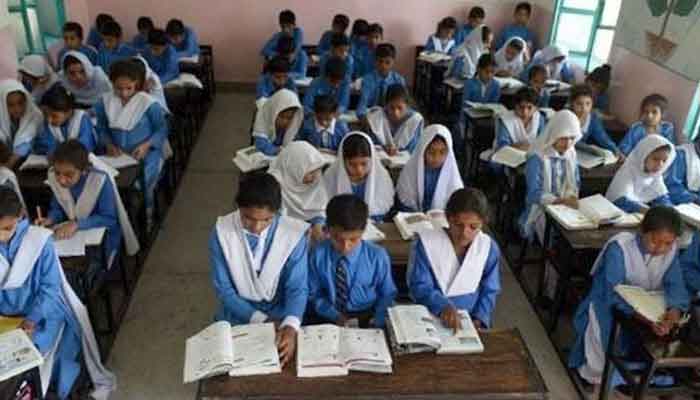Education and living conditions in the urban slums
38% of the katchi abadis do not have daily access to water and about 18% get water once in 15 days or more, says study
December 04, 2021

More than half of the urban population lives in slums in Pakistan, according to some estimates. Those living in slums are extremely marginalised and often do not have an effective voice in national discourse to highlight their plight. Analysing educational outcomes in urban slums, exclusively as part of the Annual Status of Education Report (ASER) 2021, the Idara-e-Taleem-o-Aagahi (ITA) has filled an important gap in the literature. This article will focus on the observations of the recently launched report.
The ITA’s pilot study was focused on four districts – three districts in Karachi (Karachi-West, Korangi, and Malir) and one district in Lahore. Children who participated in the survey were aged between either three and 16 years or five and 16 years; 46% of them were girls. Around 114 urban slums in these four districts were surveyed. A total of 2,275 households and around 2,285 mothers took part in this study. A two-tier rigorous sampling methodology along with standardised assessment tools was adopted.
According to the ASER report, “The living conditions in the katchi abadis (KAs) are extremely challenging. 38% of the KAs do not have daily access to water and about 18% get water once in 15 days or more; in 46% KAs there is no routine system for cleaning of drains and garbage collection. While [the] majority of the households (79%) had their own toilets, 21% either had shared (13%) or public (5%) toilets and for 3%, there was no option but open defecation.”
These poor living conditions are also reflected in the delivery of education. Around 20% of the urban slums surveyed did not have a government school. The majority of children living in the surveyed urban slums were enrolled in private schools (59%) that include madrassahs (8%) and non-formal education providers (1%) and the remaining children (41%) were enrolled in government schools. Enrolment is higher in the 5-10 age bracket, while one in three children of 16-year-old is out of school.
There are also inter-district variations. Government school enrolment is higher in Lahore (59%) while private school enrolment is higher in Korangi, Karachi (again 59%). In terms of madrassah enrolment, it varies between two and 3% in Lahore, Malir, and Korangi, and it is 24% in Karachi-West where one in four children is studying in a madrassah.
Girls relatively fall behind in terms of enrolment. With regard to evaluating learning outcomes, children studying in urban slums lag behind the ASER assessment in 2019 in these very same districts conducted as part of the ASER survey. However, the urban slums of these four districts are being assessed systematically for the first time in this pilot study.
According to the report, “In 2019, learning outcomes (5-16 years old) gathered in the same four districts revealed Urdu/Sindhi story reading at 46%, while in 2021 the four district katchi abadis, story reading in Urdu/Sindhi is 35%. For two-digit division in 2019, 41% of children were competent, while in katchi abadis in 2021, it is 26%; in 2019, 46% of children could read sentences in English, but in katchi abadis in 2021, 37% of children can read English sentences. The challenges can be interrogated by gender, institution, mother tongue, psychosocial well-being etc.”
Despite challenges, girls performed relatively better in numeracy and literacy in urban slums. Similarly, children studying in private schools showed relatively better results than those studying in government schools. Madrassah students’ educational outcomes were extremely poor. Only 7.4% could read a story in Urdu/Sindhi, 10% could read sentences in English, and 4.4% of more than 400 madrassah students (5-16 years old) who were assessed as part of the pilot study could solve division problems.
The other important factors are learning in the mother tongue, household wealth, parents’ – particularly mother’s – education, technology availability and usage that are positively correlated with higher learning outcomes of children. The report also states that psychosocial well-being is important, and as someone who has always believed and practised in never ever giving up and always having a good fight with a positive frame of mind no matter how difficult and arduous circumstances might be at some point in one’s life, one sees the wisdom in including this variable in the report while assessing children’s well-being.
Another positive finding of the report is that technology and internet usage is prevalent in the majority of houses in urban slums. Roughly 80% of the households have mobile phones – 63% even have smartphones – and 21% have laptops/computers. In total, one-third of the participating households (33%) stated that they use the internet. This shows that there is tremendous potential for web-based technology-oriented learning and livelihoods solutions.
A relatively high percentage (15%) of the population depends on social protection programmes in the urban slums surveyed compared to 11% in 16 rural districts assessed for the ASER 2021. It shows that social protection initiatives are somewhat well-targeted and there is tremendous scope to increase other social protection initiatives such as those on conditional lending to achieve better social outcomes in urban slums.
Living conditions in regularised urban slums are comparatively better than in non-regularised ones. So obviously, one policy outcome is to work towards regularisation. Working on skills development/ building life skills, carrying out more robust assessments of urban slums on a continuous basis, making a special effort to uplift the extremely poor learning outcomes of madrassah students are some of the recommendations.
The report has filled a crucial gap in the literature and has left readers and policymakers with plenty of thought to take action and improve the lives and educational standards of children and households living in urban slums of Pakistan.
The writer is an Islamabad-based social scientist.
Email: [email protected]
Originally published in The News









